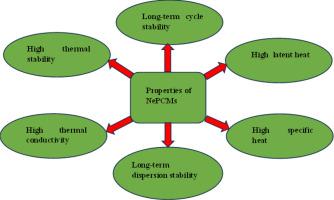热能储存系统应用的纳米增强相变材料:近期进展和未来挑战的全面回顾
Q1 Chemical Engineering
引用次数: 0
摘要
相变材料(PCMs)因其高效的储热性能而备受关注。最近的研究表明,在光伏(PV)面板中使用pcm可以提高储热系统的效率。纳米颗粒的加入提高了材料的导热性和导热性。本研究旨在回顾基于金属、碳、陶瓷和混合纳米材料的pcm的最新进展和未来挑战。最新的参考文献来自谷歌搜索引擎。结果表明,铜(20 nm)等金属纳米颗粒在相变温度变化不大的情况下,导热系数可提高46.3%,扩散系数可提高44.9%。虽然像膨胀石墨(EG)这样的碳材料表现出潜热保留的权衡,但它们的导电性是纯石蜡的40倍。陶瓷纳米颗粒,如Al2O₃和fe30o₄,增强了结构稳定性并减少了过冷,其中fe30o₄复合材料的电导率提高了60%。通过预测机器学习技术验证的混合系统集成了导电性、成核性和热稳定性,使用了石墨烯- wo₃纳米流体和SiO₂-CeO₂-石蜡等材料。这些进展突出了纳米材料在改善石蜡低导电性的同时平衡纳米颗粒的整合以保持能量密度的潜力。在解决诸如限制自然对流和降低潜热(在高填料负荷下高达35%)等权衡方面仍然存在挑战。结构上的改变,比如与Al2O₃纳米颗粒相结合的径向翅片,可以使熔化速度提高28.3%,补偿对流损失。实际应用证明了其可扩展性,cu -石蜡复合材料的效率提高了1.7%,而Gr-Ag混合材料将作业时间延长了3小时。环境友好的方法,如植物衍生的氧化铁纳米颗粒,优先考虑可持续性而不影响功能。未来的研究应该集中在可扩展的合成、最佳填料相互作用和耐久性测试上,以满足全球对有效、可持续的热能储存解决方案的需求。本文章由计算机程序翻译,如有差异,请以英文原文为准。

Nano enhanced phase change materials for thermal energy storage system applications: A comprehensive review of recent advancements and future challenges
Phase change materials (PCMs) are gaining significant attention for their efficiency in thermal energy storage. Recent research shows that PCMs can enhance heat storage systems' effectiveness when used in photovoltaic (PV) panels. By adding nanoparticles, thermal conductivity and heat transmission are improved. This study aimed to review the recent advancements and future challenges of PCMs based on metallic, carbonic, ceramic, and hybrid nanomaterials. The up-to-date references were taken from the Google search engine. Results indicated that metallic nanoparticles like copper (20 nm) can increase thermal conductivity by up to 46.3 % and diffusivity by 44.9 % with minor changes in phase transition temperatures. While carbonic materials like expanded graphite (EG) show latent heat retention trade-offs, they are 40 times more conductive than pure paraffin. Ceramic nanoparticles, such as Al2O₃ and Fe3O₄, enhance structural stability and reduce super-cooling, with Fe3O₄ composites showing a 60 % conductivity increase. Hybrid systems validated by predictive machine learning techniques integrate conductivity, nucleation, and thermal stability, using materials like graphene-WO₃ nano-fluids and SiO₂-CeO₂-paraffin. These developments highlight nanomaterials' potential to improve paraffin's low conductivity while balancing nanoparticle integration to maintain energy density. Challenges remain in addressing trade-offs like restricted natural convection and decreased latent heat (up to 35 % at high filler loadings). Structural modifications, such as radial fins combined with Al2O₃ nanoparticles, result in a 28.3 % faster melting rate, compensating for convection losses. Real-world applications demonstrate scalability, with Cu-paraffin composites achieving a 1.7 % efficiency gain and Gr-Ag hybrids extending operation by three hours. Environmentally friendly methods, such as plant-derived iron oxide nanoparticles, prioritize sustainability without compromising functionality. Future research should focus on scalable synthesis, optimal filler interactions, and durability testing to meet global demands for effective, sustainable thermal energy storage solutions.
求助全文
通过发布文献求助,成功后即可免费获取论文全文。
去求助
来源期刊

International Journal of Thermofluids
Engineering-Mechanical Engineering
CiteScore
10.10
自引率
0.00%
发文量
111
审稿时长
66 days
 求助内容:
求助内容: 应助结果提醒方式:
应助结果提醒方式:


